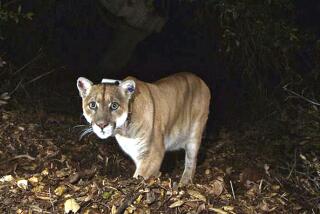Let’s finally protect mountain lions from freeways, rat poison, and angry property owners
- Share via
There’s nothing idyllic about life in Southern California for mountain lions. They get sick or die from eating prey contaminated by rat poisons. They get badly burned by wildfires. They’re hemmed in by developments and freeways, leaving them stranded in isolated groups. The commute from home turf to potential mating grounds is treacherous and sometimes fatal. A mountain lion known as P-61, one of the radio-collared cats being tracked by the National Park Service, made it successfully across the 405 Freeway last summer, only to be struck by a vehicle and killed when he tried to cross back in the predawn hours a couple of months later.
And forget about any more ambitious overland journeys. For lions in the Santa Ana Mountains and the Santa Monica Mountains who might want to venture toward one another, there’s no viable route. Each of their ranges is bordered by a lethal swath of federal highways that they would have little choice but to cross multiple times along the 100-plus-mile trek.
It’s not that any one lion would make that journey from start to finish. It’s that almost no lions can even start the trip at either end to wander into new territory along the way and begin to mix and mingle.
Even P-22, the mountain lion who famously lives among us in Griffith Park, is stuck like a recluse, with little chance of finding a mate, in a park too small for a creature whose average territory can extend to 200 square miles.
Faced with environmental dangers and weakened by genetic inbreeding, the mountain lions of the Central Coast and Southern California are so threatened that they could become extinct in a decade if the state doesn’t act now to protect them.
The California Fish and Game Commission will have its chance to do just that Thursday, when the commissioners are scheduled to vote (via teleconference) on whether to take a crucial step toward listing the animals as threatened under the California Endangered Species Act.
Last year, the Center for Biological Diversity and the Mountain Lion Foundation petitioned the commission to list the animals, contending that the genetically distinct subpopulations along the Central Coast and in Southern California are eligible for protection because they are evolutionarily significant and endangered by habitat loss, among other problems. The Department of Fish and Wildlife, which provides the commission with scientific data, has recommended the commission formally consider listing the lions as threatened.
There’s no question the commission should vote to study whether to list the lions. The study may take a year, but protections would kick in immediately, pending the commission’s final decision.
Those protections, which can’t come too soon, would help on multiple fronts. Developers building in lion habitat would be obligated not to block an existing wildlife corridor unless providing an alternative one. Any highway project that would thwart the lions’ movement across the ranges would have to be altered or include some kind of overpass or underpass or enhancement of an existing pathway for wildlife.
And while the study is underway, the state should take one additional step to preserve the lions: It should not grant any depredation permits for lions that prey on livestock or pets kept within or abutting their habitat. As awful as it is to lose those animals, it’s the owners’ responsibility to shield them from the lions whose turf they’re sharing.
Wildlife advocates say listing the lions as threatened could further restrict the use of second-generation rat poisons that are so devastating to mountain lions and other wildlife. Only licensed commercial exterminators are allowed to use them, but that hasn’t stopped mountain lions from ingesting lethal doses indirectly. Unfortunately, a proposal in the California Legislature last year to restrict use only to agricultural settings didn’t make it into law. It would be great if a formal move to protect the lions led to a ban on those rodenticides in most settings.
If we want to maintain the odd and magical blend of urban and wild in Los Angeles and beyond, we must protect the mountain lions that live with us. They not only help maintain a healthy ecosystem, they are the living history of the land we have now urbanized. Wouldn’t it be great if P-22 could wander outside of Griffith Park without risking death and find a mate?
More to Read
A cure for the common opinion
Get thought-provoking perspectives with our weekly newsletter.
You may occasionally receive promotional content from the Los Angeles Times.









